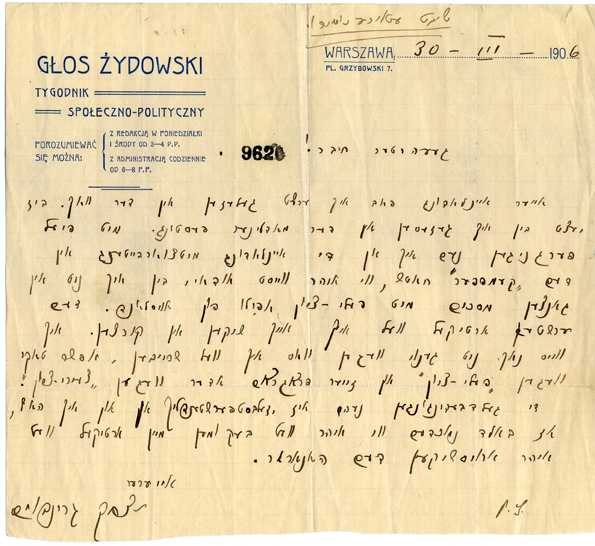Di gantse velt af a firmeblank: The World of Jewish Letterheads
Assemble the letterheads of Jewish organizations, institutions, and individuals in Europe, North and South America, and Palestine from the 1890s to the eve of World War II in 1939 and you have a portrait of the Jewish world: transnational; diverse in language, political, and religious orientation; and flourishing.
Di gantse velt af a firmeblank (The Whole World on a Letterhead) is an experiment in building that portrait. Here, we hope to bring you several times a month, a different example of letterhead from a single collection in the YIVO Archives, the Papers of Kalman Marmor.
Marmor, a Yiddish writer and cultural activist, was born October 11, 1879 in Mayshigola, Vilna Gubernia (today Maišiagala, Lithuania). In 1906, he settled in the U.S. Initially active with the Labor Zionist movement, he later became a Communist. He was an organizer of the 1937 World Yiddish Culture Congress, cultural director of the International Workers Order, and a contributor to the Communist Yiddish newspaper, Morgn Frayhayt. Between 1933 and 1936, he lived in Kiev, where he worked at the Institute of Jewish Proletarian Culture and prepared scholarly editions of the work of American Yiddish poets and writers. During Stalin’s Great Terror, the Institute was liquidated, and much of its leadership was arrested and executed. Marmor, an American citizen, returned to the U.S. He died in Los Angeles in 1956.
His papers at YIVO contain several thousand letters from the turn of the 20th century to the 1950s. He had an astonishingly diverse array of correspondents, not limited to Zionist and Communist activists.

From Yitzhak Grunbaum in Warsaw to Kalman Marmor in Philadelphia, March 30, 1906. (YIVO RG 205, Folder 118)
Yitzhak Grunbaum (1879-1970) was a labor Zionist activist and political leader who, in the years following World War I, served as a member of the Polish Sejm (Parliament) along with other representatives of Jewish parties. In 1906, around the time he wrote this letter, he was instrumental in the adoption by the Russian Zionist Federation of Gegenwartsarbeit (work for the present), an approach which emphasized focusing on the day-to-day political and social needs of Jews in the Diaspora instead of putting all efforts into striving for the establishment of a Jewish homeland.
Here, he writes on the letterhead of Głos Żydowski (Jewish Voice), a Polish-language Zionist weekly he co-edited. The time period is what is commonly called the Russian Revolution of 1905 and which, in reality, was several years of political upheaval in the Russian Empire. In fact, Grunbaum has just been released from jail, “the Modlin Fortress,” and apologizes for the delay in his response to a letter from Marmor, who has just arrived in America to take over the editorship of Yidishe kempfer, a new Poalei Zion weekly. Though Grunbaum says he is “not in complete agreement” with Poalei Zion’s platform, he responds positively to Marmor’s suggestion that he write an article for Yidishe kempfer. He says he will either write about Poalei Zion or the Zeirei Zion youth movement and expresses the hope that he will receive an honorarium for writing the piece.
Series curated by Roberta Newman; Images digitized by Vital Zajka. Biographical information on Kalman Marmor from biographical note by Daniel Soyer in the inventory to RG 205, Papers of Kalman Marmor.